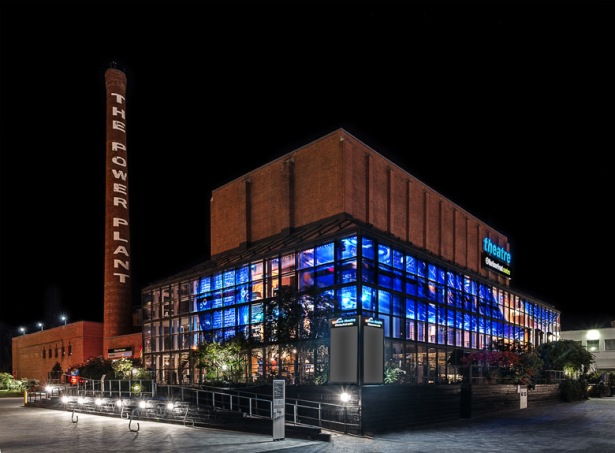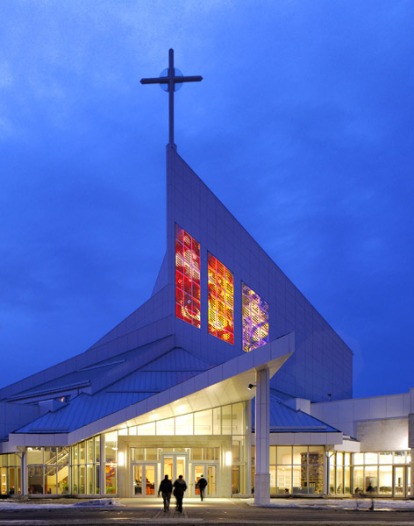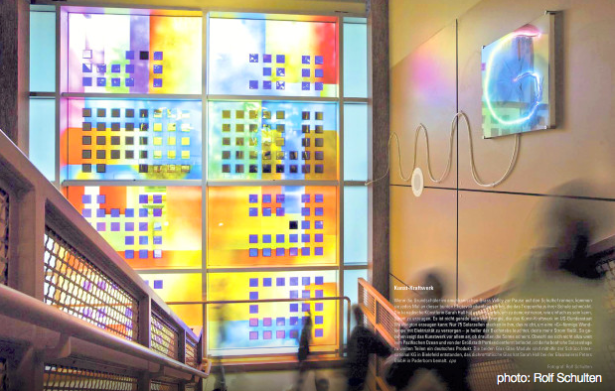This post comes from the Artists and Climate Change Blog
In the third instalment of her “Renewable Energy Artworks†monthly series, Artists & Climate Change writer Joan Sullivan interviews internationally acclaimed solar stained glass artist Sarah Hall in Toronto, Ontario.Â
Before introducing Sarah Hall’s beautiful and important work, I feel compelled to describe briefly the rapidly evolving energy landscape within which she creates. For those who have neither the time nor inclination to read about distributed energy, feel free to skip the first three paragraphs.

Micro-generation is the production of electricity on a small scale – typically using renewable energy sources such as solar and wind – to help homeowners, schools, commercial and industrial buildings, religious centres, and municipalities offset all or a portion of their electricity needs. Electricity produced, consumed, and/or stored on-site is called “distributed†since it exists at the distribution edge of the interface between consumers and conventional transmission grids that carry electricity from distant centralized coal-fired, gas, nuclear, or hydroelectric power plants.
We have all seen rooftop photovoltaic (PV) solar installations; they are the most prominent example of distributed energy generation today.
In addition to being distributed, this energy is highly disruptive: consumer-centric distributed renewable energy generation will ultimately replace our aging, profit-centric, monopolistic, centralized power stations. Author and serial entrepreneur Tony Saba has famously predicted that the centralized system of fossil fuel-based energy generation will be obsolete by 2030. Just 13 years from now. In our lifetimes. This is huge.

So what does this have to do with artists, you may ask?
Historically, artists have embraced rapid change during times of great upheaval and disruption, such as the birth of the modern art movement at the beginning of the 20th century that portended the chaos of two world wars.
In the 21st century, climate change has already become the rallying cry for artists across the globe. If Tony Saba’s predictions come true, I believe artists will also draw inspiration from the massively disruptive energy revolution — currently underway — as we witness the emergence of virtual power stations that will blur the line between energy producers and energy consumers.
Canadian stained glass artist Sarah Hall is already doing just that. In fact, she has spent the last 10 years of her 40-year career pioneering the fusion of color, light, and photovoltaic technology for architectural glass.

Hall’s large solar glass installations include: “Waterglass†at Enwave Theatre at Toronto’s Harbourfront Centre (above); “Lux Gloria†at the Cathedral of the Holy Family in Saskatoon (below); “Lux Nova†at the University of British Colombia; “Leaves of Light†for the Life Sciences Building at York University in Toronto; and “The Science of Light†at Grass Valley Elementary School in Washington State, USA.
In a 2015 interview with Michael Todd, editor of The York University Magazine, Hall describes the evolution of her solar art glass installations:
“As a glass artist working in architectural installations, the idea to bring solar into my work came from a few sources which all converged within a couple of years. First, my mentor, Professor Ursula Franklin at Massey College, University of Toronto, encouraged me to explore connections to solar. Her physics colleagues in Santa Barbara had created a wonderful video “Power of the Sun†which she gave me. Second, I had seen many beautiful buildings in Europe creating in a technique called Building Integrated Photovoltaic (BIPV) and was convinced it was a great direction for solar. Third, I made connections in Canada, the US and Europe with architects and engineers working in the field of BIPV. Fourth, the studio in Germany where my work is produced made a prototype of art glass with embedded solar cells and encouraged me to create solar work. Fifth, and of great importance, was that I received a Chalmers Arts Fellowship from the Ontario Arts Council which gave me the time and resources to experiment with the integration of solar collection into my art glass projects. I am interested in using solar primarily as an environmental advocacy/educational tool.â€
Hall further explained her multidisciplinary collaborative process to me:
“My projects are essentially collaborations with solar engineers. These projects have brought a rigour to my process of designing art glass because they require me to incorporate rigid graphic elements. There is a very big learning curve for everyone involved – and you need the team of engineers and electricians from the site to be on board with work they have never done before. This part of it can be very hard going and so I am very pleased with bringing many people into a new idea of solar – that it can both look beautiful and carry meaning. The windows at the Cathedral in Saskatoon are important for me as a world first – a Cathedral whose stained glass windows are connected to the grid that results in an energy rebate for the Cathedral.â€

Each of Sarah Hall’s solar glass installations is unique, beautiful and wondrous. Each converts solar energy into electricity, but the end use of that electricity varies according to the intended design of the architectural glass. For example, two of her solar installations – “Lux Nova†and “Leaves of Light†(below) – were designed to absorb and store sunlight into the structure by day and then, when darkness falls, use this stored electricity to illuminate/backlight the glass. The result is a stunning sculpture that glows in the dark.

In contrast, Hall’s “Waterglass†and “Lux Gloria†installations were designed specifically to produce clean electricity that feeds directly into their respective buildings’ energy systems.
I am particularly fond of Hall’s “Science of Light†installation at Grassy Valley Elementary School, which transforms the school’s main stairwell into an ever-changing flood of color and light, depending upon the time of day and season. This stairwell must be a delight for the students running up and down the stairs to their classes.

This “teaching†window was one element in a larger project designed by DOWA Portland architects Barry Deister and Keith Johnson to showcase a variety of green technologies at an elementary school in northwestern United States: a roof garden, wind turbines, a community garden, and Hall’s solar art glass. A lovely sitting area was created at the stairwell’s main landing to encourage students, parents, and staff to pause, contemplate and enjoy the transformative color and light show.

But what excites me most about this project is that Sarah designed it specifically “to delight, to teach, and to inspire.†The innovative use of solar cells embedded into the windows “offers students an ongoing lesson in science, ecology, and the positive use of technology.†How I wish I had gone to a school like this! I am sure that Hall’s magnificent teaching window will inspire many of these young students to study STEAM (science, technology, engineering, art, math) in order to learn to collaborate across disciplines – as Sarah Hall is doing – to design and build our post-carbon future.
Here is a short video on Hall’s solar glass for art and architecture:
All photos courtesy of Sarah Hall Studio.
Follow Joan Sullivan on Twitter @CleanNergyPhoto
About Artists and Climate Change:
Artists and Climate Change is a blog that tracks artistic responses from all disciplines to the problem of climate change. It is both a study about what is being done, and a resource for anyone interested in the subject. Art has the power to reframe the conversation about our environmental crisis so it is inclusive, constructive, and conducive to action. Art can, and should, shape our values and behavior so we are better equipped to face the formidable challenge in front of us.


